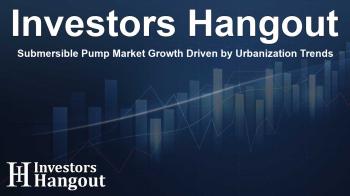Submersible Pump Market Growth Driven by Urbanization Trends

Overview of the Submersible Pump Market
The global submersible pump market has exhibited significant growth, valued at USD 14.75 billion recently and projected to soar to USD 23.07 billion over the coming years. This impressive growth translates to a robust compound annual growth rate (CAGR) of 5.75% from 2025 through 2032.
Factors Driving Market Growth
One of the primary motivating factors behind this market expansion can be attributed to the increasing demand for submersible pumps within various sectors, particularly agriculture, oil and gas, water supply, wastewater treatment, and mining. This versatile equipment plays a crucial role in handling fluids under diverse conditions, enhancing its applicability in an ever-expanding range of projects.
Urbanization and Infrastructure Investment
Urbanization, especially in developing economies, is accelerating the need for efficient water and wastewater management. Governments are significantly investing in infrastructure to address this exact need. Projects that incorporate improved pump designs and materials contribute to extending the lifespan of submersible pumps while lowering energy consumption, thus promoting sustainable practices across industries.
Prevalence of Submersible Pumps in the U.S. Market
The submersible pump market in the U.S. is also showing robust growth potential, anticipated to escalate from USD 2.30 billion to approximately USD 3.72 billion by 2032, showcasing a CAGR of 6.17%. This growth is fueled by a mature infrastructure requiring upgrades, particularly in sewage and wastewater treatment systems and urban water management investments.
Renewal of Aging Infrastructure
The increasing need to replace outdated municipal water structures with energy-efficient models creates a thriving marketplace for submersible pumps. This trend indicates not only an environmental necessity but also a strategic investment in public health and safety.
Key Players in the Market
Several key companies are spearheading innovation within the submersible pump industry. Major players include Xylem, Zoeller Company, Sulzer Ltd, Kirloskar Brothers Limited, Wilo SE, Atlas Copco, Shakti Pumps, Hitachi Industrial Equipment Systems Co., Ltd., Crompton Greaves Consumer Electricals Limited, and Tsurumi Pump. These companies are essential to the market, driving technological advancements and expanding product offerings.
Market Composition by Capacity and Type
Within the submersible pump market, medium-capacity pumps dominate, capturing 71.8% of the share. Their extensive usage across agriculture, residential areas, and small industries illustrates their versatility. Electrical submersible pumps (ESPs) make up a significant portion of the market due to their high efficiency and reliability, making them particularly desirable in the oil and gas sectors.
End-User Segment Dynamics
The water and wastewater sector holds the largest market share, primarily due to growing global attention towards water resource management and enhanced regulatory standards. Submersible pumps have proven vital in municipal and industrial applications that entail sewage and sludge management.
Regional Insights
Asia-Pacific commands the largest share of the submersible pump market, holding around 48.00% as of now. Growing industrialization and urbanization coupled with increased agricultural investments in countries like China and India lead to this dominance. In particular, India’s extensive initiatives to improve groundwater access further bolster the demand for borewell submersible pumps.
Innovations and Recent Developments
New innovations are reshaping the landscape of the submersible pump market. For instance, Grundfos has launched energy-optimized SP Series submersible pumps tailored specifically for deep-well water extraction in agricultural and municipal frameworks. Meanwhile, KSB SE & Co. KGaA is expanding its production facilities to meet the rising demands across Southeast Asia and Africa, ensuring a steady supply of these essential devices.
Frequently Asked Questions
What is the projected growth rate for the submersible pump market?
The submersible pump market is expected to grow at a CAGR of 5.75% from 2025 to 2032.
Which sectors are driving the demand for submersible pumps?
The agriculture, oil and gas, water supply, wastewater treatment, and mining sectors are the primary drivers of demand for submersible pumps.
What are the major challenges facing the submersible pump market?
Challenges include the need for sustainable practices, energy efficiency, and adapting to new environmental regulations.
Who are the key players in the submersible pump market?
Notable players include Xylem, Sulzer Ltd, Wilo SE, and others committed to innovation and quality.
How do submersible pumps contribute to environmental sustainability?
Submersible pumps enhance energy efficiency and prolong water resource management, essential for sustainable environmental practices.
About The Author
Contact Riley Hayes privately here. Or send an email with ATTN: Riley Hayes as the subject to contact@investorshangout.com.
About Investors Hangout
Investors Hangout is a leading online stock forum for financial discussion and learning, offering a wide range of free tools and resources. It draws in traders of all levels, who exchange market knowledge, investigate trading tactics, and keep an eye on industry developments in real time. Featuring financial articles, stock message boards, quotes, charts, company profiles, and live news updates. Through cooperative learning and a wealth of informational resources, it helps users from novices creating their first portfolios to experts honing their techniques. Join Investors Hangout today: https://investorshangout.com/
The content of this article is based on factual, publicly available information and does not represent legal, financial, or investment advice. Investors Hangout does not offer financial advice, and the author is not a licensed financial advisor. Consult a qualified advisor before making any financial or investment decisions based on this article. This article should not be considered advice to purchase, sell, or hold any securities or other investments. If any of the material provided here is inaccurate, please contact us for corrections.

